
The Space Shuttle is a retired, partially reusable low Earth orbital spacecraft system operated from 1981 to 2011 by the U.S. National Aeronautics and Space Administration (NASA) as part of the Space Shuttle program. Its official program name was Space Transportation System (STS), taken from a 1969 plan for a system of reusable spacecraft where it was the only item funded for development.

Space Shuttle Discovery is a retired American spacecraft. The spaceplane was one of the orbiters from NASA's Space Shuttle program and the third of five fully operational orbiters to be built. Its first mission, STS-41-D, flew from August 30 to September 5, 1984. Over 27 years of service it launched and landed 39 times, aggregating more spaceflights than any other spacecraft to date. The Space Shuttle launch vehicle had three main components: the Space Shuttle orbiter, a single-use central fuel tank, and two reusable solid rocket boosters. Nearly 25,000 heat-resistant tiles cover the orbiter to protect it from high temperatures on re-entry.

Space Shuttle Atlantis is a retired Space Shuttle orbiter vehicle which belongs to NASA, the spaceflight and space exploration agency of the United States. Atlantis was manufactured by the Rockwell International company in Southern California and was delivered to the Kennedy Space Center in Eastern Florida in April 1985. Atlantis is also the fourth operational and the second-to-last Space Shuttle built. Its maiden flight was STS-51-J made from October 3 to 7, 1985.
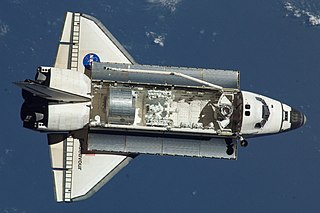
Space Shuttle Endeavour is a retired orbiter from NASA's Space Shuttle program and the fifth and final operational Shuttle built. It embarked on its first mission, STS-49, in May 1992 and its 25th and final mission, STS-134, in May 2011. STS-134 was expected to be the final mission of the Space Shuttle program, but with the authorization of STS-135 by the United States Congress, Atlantis became the last shuttle to fly.
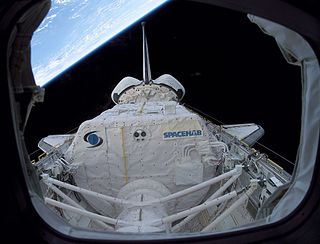
STS-107 was the 113th flight of the Space Shuttle program, and the 28th flight of Space Shuttle Columbia. The mission ended, on February 1, 2003, with the Space Shuttle Columbia disaster which killed all seven crew members and destroyed the space shuttle. It was the 88th post-Challenger disaster mission.

Kalpana Chawla was an Indian-born American astronaut and aerospace engineer who was the first woman of Indian origin to fly to space. She first flew on Space Shuttle Columbia in 1997 as a mission specialist and primary robotic arm operator.
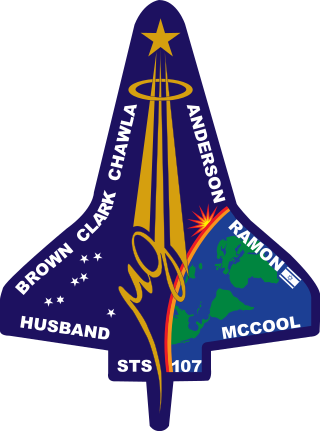
On February 1, 2003, Space Shuttle Columbia disintegrated as it reentered the atmosphere over Texas and Louisiana, killing all seven astronauts on board. It was the second Space Shuttle mission to end in disaster, after the loss of Challenger and crew in 1986.

The Columbia Accident Investigation Board (CAIB) was an internal commission convened by NASA to investigate the destruction of the Space Shuttle Columbia during STS-107 upon atmospheric re-entry on February 1, 2003. The panel determined that the accident was caused by foam insulation breaking off from the external fuel tank, forming debris which damaged the orbiter's wing, and that the problem of "debris shedding" was well known but considered "acceptable" by management. The panel also recommended changes that should be made to increase the safety of future shuttle flights. The CAIB released its final report on August 26, 2003.
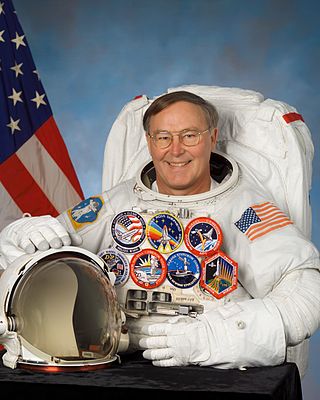
Jerry Lynn Ross is a retired United States Air Force officer, engineer, and a former NASA astronaut. Ross is a veteran of 7 Space Shuttle missions, making him the joint record holder for most spaceflights.

STS-114 was the first "Return to Flight" Space Shuttle mission following the Space Shuttle Columbia disaster. Discovery launched at 10:39 EDT, July 26, 2005. The launch, 907 days after the loss of Columbia, was approved despite unresolved fuel sensor anomalies in the external tank that had prevented the shuttle from launching on July 13, its originally scheduled date.

STS-121 was a 2006 NASA Space Shuttle mission to the International Space Station (ISS) flown by Space ShuttleDiscovery. The main purposes of the mission were to test new safety and repair techniques introduced following the Columbia disaster of February 2003 as well as to deliver supplies, equipment and German European Space Agency (ESA) astronaut Thomas Reiter to the ISS.
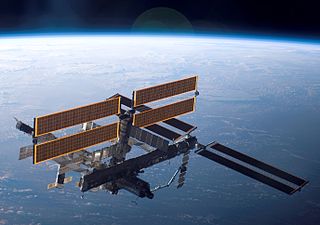
STS-115 was a Space Shuttle mission to the International Space Station (ISS) flown by Space ShuttleAtlantis. It was the first assembly mission to the ISS after the Columbia disaster, following the two successful Return to Flight missions, STS-114 and STS-121. STS-115 launched from LC-39B at the Kennedy Space Center on September 9, 2006, at 11:14:55 EDT.

Soichi Noguchi is a Japanese aeronautical engineer and former JAXA astronaut. His first spaceflight was as a mission specialist aboard STS-114 on 26 July 2005 for NASA's first "return to flight" Space Shuttle mission after the Columbia disaster. He was also in space as part of the Soyuz TMA-17 crew and Expedition 22 to the International Space Station (ISS), returning to Earth on 2 June 2010. He is the sixth Japanese astronaut to fly in space, the fifth to fly on the Space Shuttle, and the first to fly on Crew Dragon.
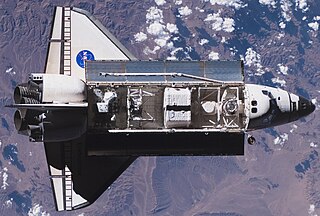
STS-118 was a Space Shuttle mission to the International Space Station (ISS) flown by the orbiter Endeavour. STS-118 lifted off on August 8, 2007, from launch pad 39A at Kennedy Space Center (KSC), Florida and landed at the Shuttle Landing Facility at KSC on August 21, 2007.
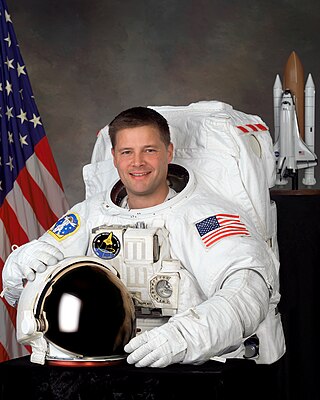
Douglas Harry "Wheels" Wheelock is an American engineer and astronaut. He has flown in space twice, logging 178 days on the Space Shuttle, International Space Station, and Russian Soyuz. On July 12, 2011, Wheelock announced that he would be returning to active duty with the United States Army in support of Operation Enduring Freedom. He is currently working with NASA to test the Orion spacecraft at the Glenn Research Center in Plum Brook, Ohio.

STS-133 was the 133rd mission in NASA's Space Shuttle program; during the mission, Space Shuttle Discovery docked with the International Space Station. It was Discovery's 39th and final mission. The mission launched on February 24, 2011, and landed on March 9, 2011. The crew consisted of six American astronauts, all of whom had been on prior spaceflights, headed by Commander Steven Lindsey. The crew joined the long-duration six person crew of Expedition 26, who were already aboard the space station. About a month before lift-off, one of the original crew members, Tim Kopra, was injured in a bicycle accident. He was replaced by Stephen Bowen.

STS-124 was a Space Shuttle mission, flown by Space Shuttle Discovery to the International Space Station. Discovery launched on May 31, 2008, at 17:02 EDT, moved from an earlier scheduled launch date of May 25, 2008, and landed safely at the Kennedy Space Center's Shuttle Landing Facility, at 11:15 EDT on June 14, 2008. Its objective was to deliver the largest module of the space station – Kibō, the Japanese Experiment Module pressurized section. The mission is also referred to as ISS-1J by the ISS program.

STS-132 was a NASA Space Shuttle mission, during which Space Shuttle Atlantis docked with the International Space Station on May 16, 2010. STS-132 was launched from the Kennedy Space Center on May 14, 2010. The primary payload was the Russian Rassvet Mini-Research Module, along with an Integrated Cargo Carrier-Vertical Light Deployable (ICC-VLD). Atlantis landed at the Kennedy Space Center on May 26, 2010.

Nicole Marie Passonno Stott is an American engineer and a retired NASA astronaut. She served as a flight engineer on ISS Expedition 20 and Expedition 21 and was a mission specialist on STS-128 and STS-133. After 27 years of working at NASA, the space agency announced her retirement effective June 1, 2015. She is married to Christopher Stott, a Manx-born American space entrepreneur.

STS-135 was the 135th and final mission of the American Space Shuttle program. It used the orbiter Atlantis and hardware originally processed for the STS-335 contingency mission, which was not flown. STS-135 launched on July 8, 2011, and landed on July 21, 2011, following a one-day mission extension. The four-person crew was the smallest of any shuttle mission since STS-6 in April 1983. The mission's primary cargo was the Multi-Purpose Logistics Module (MPLM) Raffaello and a Lightweight Multi-Purpose Carrier (LMC), which were delivered to the International Space Station (ISS). The flight of Raffaello marked the only time that Atlantis carried an MPLM.





















